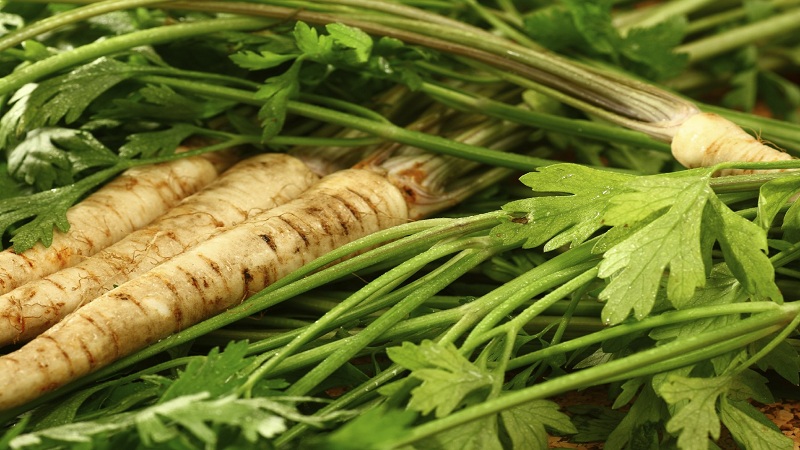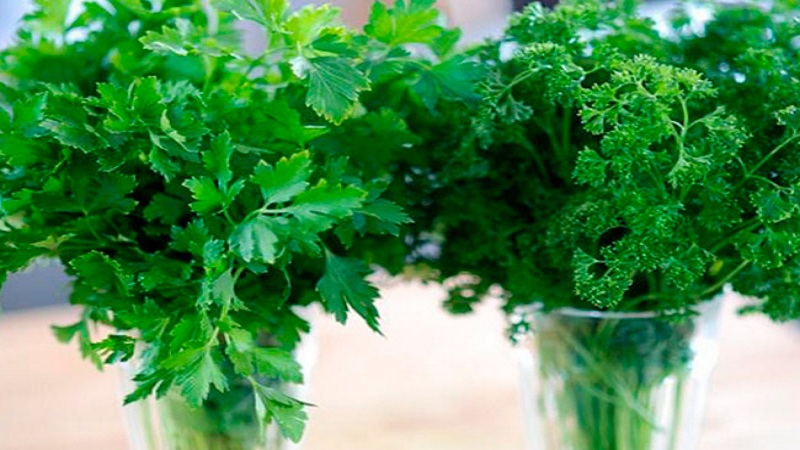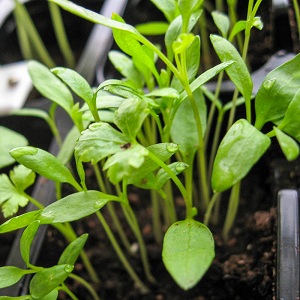A beginner gardener's guide to growing parsley
Leafy parsley smooth-leaved and curly is a very common greenery in our latitudes. It is suitable for growing in the open field, greenhouse and on the balcony.
Root parsley is less popular, but it also deserves attention due to its excellent taste and ease of care. The technology of cultivation of the crop is not laborious, and the resistance to cold and the possibility of winter sowing allow it to be grown everywhere.
The content of the article
Variety selection
The choice of variety depends on the desired speed of obtaining fresh greens, type (leaf or root), appearance of leaves (smooth or curly), period landing.
Popular varieties of early leaf parsley (ripening period 60-65 days):
- Aster;
- Gloria;
- Natalka;
- Beads;
- Russian feast;
- Chastushka.
Mid-season varieties (ripening period - 70-80 days):
- Italian giant;
- Breeze;
- Sandwich.
Mid-season varieties of root varieties:
- Healer;
- Eastern;
- Konica;
- Eagle;
- Sugar;
- Yielding;
- Lyubasha;
- The final;
- Bordwick.
Late-ripening root varieties:
- Alba;
- The final;
- Carnival.
The late-ripening leaf variety Bogatyr is suitable for podzimny planting. For spring sowing - leafy varieties: Ordinary, Astra, Breeze, Astra, Festivalnaya.
Popular is the root variety Yielding for planting in spring with a ripening period of 130 days.
Popular varieties of leafy curly parsley:
- Mazin;
- Triplex;
- Esmeralda.
In the photo - leafy and curly parsley.


Landing dates
When to sow parsley? Sowing dates depend on the type of crop:
- Root parsley is sown in the last days of April, after the air warms up to + 1 ... + 2 ° С, and the soil is at least 2 cm deep.
- Leaf parsley is planted in late April - early May. Conveyor planting is possible every 2 weeks in July - August.
- To harvest the early harvest of the leafy variety, sowing under winter is performed in October - November.
Crop rotation rules
The best predecessors of the culture are cabbage, onions, zucchini, tomatoes, squash, cucumbers, potatoes. Parsley feels good next to plantings of dill, beans, peas, cilantro, carrots.
It is not recommended to sow the plant after celery, fennel, coriander, dill.
Seed preparation
Parsley seeds contain essential oils that make them difficult to germinate... Stratification will help increase the germination of the material. About two weeks before sowing, the seeds are soaked in warm water for two days. The water is changed 2 times a day.
Swollen seeds are washed with clean water, wrapped in a moist thin cotton cloth and left at room temperature for 4-6 days until sprouts appear. Then the bundle is placed on the lower shelf of the refrigerator for 10-12 days, after which it is dried until flowable.
Reference. Seed stratification is performed before spring planting. In the fall, untreated seeds are buried in the ground.
Soil preparation
The site chosen for planting parsley is prepared in the fall: it is dug to the depth of a bayonet shovel, cleaned of plant residues and fertilized with humus (5 g per 1 m²) and wood ash (200-250 g per 1 m²). The culture responds well to organics.
In spring, the soil is loosened, mineral fertilizers are applied (25 g of double superphosphate, 30 g of potassium salt, 25 g of "Nitrofoski" per 1 m²) and leveled.
Sowing rules
Seeds with foliage of parsley are sealed to a depth of 1-1.5 cm with an interval of 8-10 cm, observing the gap between the furrows of 20-30 cm. Sprinkle the top with earth and mulch the beds with hay or straw.
Root parsley is planted to a depth of 2 cm with an interval of 20 cm according to the scheme of 30 × 30 cm. A centimeter layer of earth is poured on top. Then the soil is watered with warm clean water and covered with foil for 2-3 days. This is a classic technology for planting the root variety in regions with warm and temperate climates.
In Siberia and the Urals, it is rational to carry out podzimny sowing to a depth of 2-2.5 cm. The beds are not watered and must be mulched with sawdust, straw or peat. Seeds germinate 12-14 days after the snow melts.
How to grow parsley

The frequency of watering depends on the type of parsley grown: the leaf is watered regularly every other day to replenish the green mass, root intensively moisturize at the end of August, during the period of active growth of root crops.
It is important to avoid waterlogging. For irrigation, use warm water, since cold water slows down the development of the plant. In rainy weather, watering is temporarily canceled. In drought, it is permissible to moisten the beds daily.
Weeding is carried out as the weeds grow. At the beginning of the growing season, parsley is too sensitive to them and slows down growth. Weed grasses are removed not only from the beds, but also in the aisles. The easiest way to do this is after rain, then the plants can be pulled along with the roots.
Loosening the earth crust after rain and watering provides an additional flow of oxygen to the root system.
Thinning is performed as the parsley grows to provide sunlight access to the young shoots and improve mineral and moisture saturation. It is impossible to get large root parsley without thinning. The first procedure is performed after the emergence of shoots, leaving 2-3 cm between the shoots. Thinning again after 14 days, leaving a gap of 5-7 cm.
Leafy parsley feed nitrogen fertilizers 2 times per season in the amount of 5 g per 1 m². The first portion is applied 5 days after germination, the second - 7 days after the first. Do not exceed the dosage due to the accumulation of nitrates in the stems and leaves with an excess of nitrogen. A month before the first harvesting of greenery, the plantings are fed with a mixture of 40 g of superphosphate and 20 g of potassium salt or 150-200 g of wood ash per 1 m².
The first feeding of root parsley is performed after the appearance of 3-4 true leaves - 15 g of ammonium nitrate is added per 1 m². The second portion of fertilizers is applied 3 weeks after the first - 5 g of ammonium nitrate and potassium salt, 10 g of superphosphate per 1 m².
Disease and pest control
Parsley is most often sick:
- peronosporosis - white spots on foliage;
- white rot - the roots rot and soften;
- white spot - whitish spots appear on the foliage, the tissues soften and rot;
- black rot - darkening and decay of the root collar;
- rust - red-orange spots not green.
These diseases occur as a result of a violation of agricultural technology. In order to prevent infection, it is recommended:
- observe crop rotation;
- maintain optimal soil moisture;
- remove weeds;
- to process plantings with Fitosporin, Energen;
- warm up the seeds before sowing up to + 45 ... + 50 ° С.
To prevent the spread of fungal infections, treatment of the site with copper sulfate, copper oxychloride, "Fitosporin", "Fundazim", "Quadris", "Skor", "Baylon" will help.
Effective folk remedies:
- 1 liter of sour milk per 10 liters of water;
- 1/3 soda ash and 25 ml of liquid soap per 1 liter of water;
- 1 liter of wood ash for 5 liters of hot water;
- Boil 1 kg of fresh field horsetail in 10 liters of water and leave for 24 hours;
- 1/2 bucket of marigold inflorescences and 25 ml of liquid soap per 10 liters of water.
Processing is performed once every 7 days. Fermented milk solution can be sprayed on plants daily.
Plantings of leaf and root parsley are often attacked by carrot flies, aphids, and stem nematodes.
To scare off planting pests:
- dust with a mixture of tobacco dust and wood ash 1: 1, cover with lutrasil with a density of 17 g / m²;
- spray with "Fitoverm" or "Iskra Bio" 2-3 times every 10 days.
Safe folk remedies for insects:
- Insist 200 g of onion husks in 5 liters of warm water for 3 hours, add 50 g of soap;
- Insist 200 g of tobacco dust in 5 liters of water for 2 days;
- Insist 150 g of chamomile in 1 liter of water for 12 hours, add 5 liters of water and add 25 ml of liquid soap;
- 4 tbsp. l. vinegar 9% per 5 liters of water;
- 1 tbsp. l. ammonia per 1 liter of water;
- 5 tbsp. l. soda for 5 liters of water;
- 200 ml of milk and 30 drops of iodine in 2 liters of water.
Features of growing in the open field
Growing parsley in the open field does not cause difficulties even for novice gardeners. To get a rich harvest of greens, it is important to follow the rules of sowing and planting care:
- It is undesirable to plant seeds too deeply - this hinders their germination due to the limited access of oxygen, heat and water. To wake up, the seeds consume a large amount of nutrients, which may not be enough for the further development of plants, and the seedlings will die in the soil.
- Sowing seeds too shallow is not recommended due to the high risk of drying out and being blown out by the wind. The optimum planting depth is 1.5 cm for leaf parsley and 2 cm for root parsley.
- It is better to compact the bottom of the furrows to facilitate the access of water from the lower layers of the soil.
- It is recommended that you mix parsley seeds and lettuce to help control weeds. This plant germinates before parsley, marking the rows, so weeding can be done carefully without damaging future seedlings.
- The main condition for caring for parsley is regular loosening. Experienced gardeners claim that two-fold loosening of the soil can replace one watering. The procedure is best done after watering, when the soil dries out a little. In drought, it is recommended to loosen the beds to a depth of 3-5 cm, breaking the earthen crust.
In the greenhouse
Parsley can also be grown in greenhouse conditions, following the same care rules as in the open field. This method is more suitable for growing greenery for sale or when planting together with other crops.
2 g of stratified seeds are sown on 1 m². Seedlings appear in 8-10 days at a temperature of + 2 ° C.
The optimum air temperature for plant development is + 10 ... + 15 ° С. At elevated temperatures, the leaves turn yellow and fall off, at low temperatures, the root system freezes.
On the balcony
Leaf parsley is one of the pickiest crops to grow on the balcony. The plant does not need special conditions and labor costs.
The seeds are sown in a ready-made substrate from a gardening store. Long boxes are disinfected with a solution of potassium permanganate, drainage is placed on the bottom and filled with moist soil mixture. The prepared seeds are sown into furrows 5 mm deep, covered with earth and covered with foil. After the emergence of seedlings, the shelter is removed.
Seedlings are watered every other day. When the seedlings get stronger, they are transferred to a sunny windowsill and thinned out, leaving a gap of 3-4 cm. The first greens are cut 5-6 weeks after germination.
Reproduction
Parsley is propagated by seeds, which are harvested in the second year of the growing season. Plants are cut and stacked in rows to dry. After 4-6 days, the seeds are threshed, dried and the excess husk is removed.
The planting material is folded into paper or cloth bags and put away in a dark place, away from foreign odors.
Harvesting and storage
The root parsley is harvested in late September - early October. For this, choose a sunny and dry weather. The greens are cut off, the roots are pulled out, the earth is shaken off and left to dry in the garden.
Then the crop is sorted, the rotten and damaged roots are thrown away, the healthy ones are folded into boxes with their heads up and sprinkled with sand. The optimum storage temperature is 0 ... + 15 ° С.
The root can be stored in the refrigerator. The tops and tails are cut off, the roots are placed in perforated bags.
Parsley is harvested throughout the growing season:
- the tops are cut off, the inner foliage is left so as not to retard further growth;
- for cutting, the stems are selected on which all three leaves are ripe.
You can parsley store in the freezer, grease in jars and dry.
Fresh herbs are stored for 12-15 days in the refrigerator at a temperature of 0 ... + 5 ° C.
The nuances of growing in different regions
The time of sowing parsley in open ground depends on the growing region:
- in the south, spring sowing is carried out in early March, as soon as the snow melts;
- in the Far East - at the end of March;
- in the Urals, in Siberia and in the north of the European part of Russia - at the end of April.
The further south the region is, the later the winter sowing is carried out. In the southern regions, parsley is sown in the last days of November, in the northern ones - no later than the end of October.
In regions with cold climates, the seedling method of growing root parsley is practiced:
- sowing work is carried out in the second half of March;
- the soil from the garden is disinfected with "Fitosporin", potassium permanganate or copper sulfate, the substrate from the store is heated in an oven or double boiler;
- seedlings are grown at a temperature of + 23 ... + 25 ° C;
- soil moisture is maintained at a constant level;
- after the appearance of the first true leaves, the temperature is reduced to + 18 ° C;
- the seedlings are transferred to a permanent place in mid-May.
The rest of the cultivation technique is the same for all regions.
Conclusion
Parsley is not demanding on climatic conditions, it only needs to adhere to the irrigation regime, thinning, fertilization and regular loosening of the beds together with weeding.
The cold resistance of the plant allows sow seeds before winter for an early harvest of greens. The conveyor sowing method (every 2 weeks) is convenient for those who grow parsley for sale, and allows you to consistently harvest fresh crops.